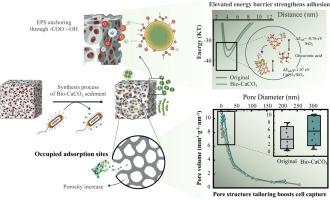Using bio-based CaCO3 functionalized sediment to simultaneously remove algae and COD through adsorption and sedimentation in water source reservoirs
IF 12.4
1区 环境科学与生态学
Q1 ENGINEERING, ENVIRONMENTAL
引用次数: 0
Abstract
In-situ turbidity enhancement can suppress algal growth in reservoirs but often exacerbates chemical oxygen demand (COD) accumulation due to incomplete organic removal. This study presents a biologically synthesized bio-CaCO3-modified sediment, engineered via Bacillus-induced carbonate precipitation, to simultaneously control algae and reduce COD. The material forms 15–30 nm core–shell clusters with enriched –OH/–COOH groups and mesopores (∼19.76 nm), confirmed by SEM, XRD, FTIR, and BET (+1.02 m2 g-1). Adsorption tests against Microcystis aeruginosa, Chlorella, and Limnothrix showed Langmuir-type monolayer binding (R2 > 0.97) and pseudo-second-order kinetics. XDLVO theory and DFT analysis revealed strong EPS–Bio-CaCO3 interactions ( = 31.28 mJ m-2; = –1.07 ev). Optimal conditions (7.5 wt % CaCO3, 56 % residual Ca2+, 85 min) achieved 93.8 % Chl-a removal, 88.6 % COD reduction, and 87.5 % turbidity control (R2 = 0.98), with minimal Ca2+ leaching. By integrating chemisorption, interfacial adhesion, and pore confinement, this material provides a stable, eco-friendly strategy for dual pollutant control and in-situ sediment remediation.


利用生物基CaCO3功能化沉积物,通过吸附沉降同时去除水源地水库中的藻类和COD
原位浊度增强可以抑制储层中藻类的生长,但由于有机去除不完全,往往会加剧化学需氧量(COD)的积累。本研究提出了一种生物合成的生物caco3改性沉积物,通过芽孢杆菌诱导碳酸盐沉淀,同时控制藻类和降低COD。通过SEM, XRD, FTIR和BET (+1.02 m2 g-1)证实,该材料形成15-30 nm的核壳团簇,具有丰富的-OH / -COOH基团和介孔(~ 19.76 nm)。对铜绿微囊藻、小球藻和Limnothrix的吸附试验显示langmuir型单层结合(R2 > 0.97)和准二级动力学。XDLVO理论和DFT分析显示EPS-Bio-CaCO3相互作用强(ΔEAB = 31.28 mJ - m-2; ΔEads = -1.07 ev)。最佳条件(7.5 wt% CaCO3, 56%残余Ca2+, 85 min)实现了93.8%的Chl-a去除率,88.6%的COD降低和87.5%的浊度控制(R2 = 0.98),Ca2+浸出最小。通过整合化学吸附、界面粘附和孔隙约束,这种材料为双重污染物控制和原位沉积物修复提供了一种稳定、环保的策略。
本文章由计算机程序翻译,如有差异,请以英文原文为准。
求助全文
约1分钟内获得全文
求助全文
来源期刊

Water Research
环境科学-工程:环境
CiteScore
20.80
自引率
9.40%
发文量
1307
审稿时长
38 days
期刊介绍:
Water Research, along with its open access companion journal Water Research X, serves as a platform for publishing original research papers covering various aspects of the science and technology related to the anthropogenic water cycle, water quality, and its management worldwide. The audience targeted by the journal comprises biologists, chemical engineers, chemists, civil engineers, environmental engineers, limnologists, and microbiologists. The scope of the journal include:
•Treatment processes for water and wastewaters (municipal, agricultural, industrial, and on-site treatment), including resource recovery and residuals management;
•Urban hydrology including sewer systems, stormwater management, and green infrastructure;
•Drinking water treatment and distribution;
•Potable and non-potable water reuse;
•Sanitation, public health, and risk assessment;
•Anaerobic digestion, solid and hazardous waste management, including source characterization and the effects and control of leachates and gaseous emissions;
•Contaminants (chemical, microbial, anthropogenic particles such as nanoparticles or microplastics) and related water quality sensing, monitoring, fate, and assessment;
•Anthropogenic impacts on inland, tidal, coastal and urban waters, focusing on surface and ground waters, and point and non-point sources of pollution;
•Environmental restoration, linked to surface water, groundwater and groundwater remediation;
•Analysis of the interfaces between sediments and water, and between water and atmosphere, focusing specifically on anthropogenic impacts;
•Mathematical modelling, systems analysis, machine learning, and beneficial use of big data related to the anthropogenic water cycle;
•Socio-economic, policy, and regulations studies.
 求助内容:
求助内容: 应助结果提醒方式:
应助结果提醒方式:


